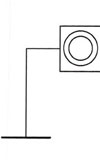The Long Bolt
 Many years ago, as a young and somewhat naive apprentice, I was told by my training supervisor to go to the engineering stores and ask for ‘a long wait.’ Thinking that this was some form of specialised turning tool, I dutifully did as requested only to be told after 10 minutes at the counter “You’ve had your long wait, now clear off!” Engineers and former apprentices of a certain age might recognise my continuing embarrassment. So when the idea of the ‘long bolt’ was first suggested it took some time to dispel thoughts of a possible prank before looking into its merits - should it have any. In conventional reciprocating technology combustion pressures are reacted via the piston and con rod into the crankshaft. Once transmitted into the lower crankcase the combination of forces generated by this combustion and those of the inertia of the piston and rod, try to force the lower bearing cap to part with the rest of the cylinder block. This force is resisted by the main bearing cap bolts.
Many years ago, as a young and somewhat naive apprentice, I was told by my training supervisor to go to the engineering stores and ask for ‘a long wait.’ Thinking that this was some form of specialised turning tool, I dutifully did as requested only to be told after 10 minutes at the counter “You’ve had your long wait, now clear off!” Engineers and former apprentices of a certain age might recognise my continuing embarrassment. So when the idea of the ‘long bolt’ was first suggested it took some time to dispel thoughts of a possible prank before looking into its merits - should it have any. In conventional reciprocating technology combustion pressures are reacted via the piston and con rod into the crankshaft. Once transmitted into the lower crankcase the combination of forces generated by this combustion and those of the inertia of the piston and rod, try to force the lower bearing cap to part with the rest of the cylinder block. This force is resisted by the main bearing cap bolts.
But, as subscribers to Newton’s third law will testify, to every action there is an equal and opposite reaction and the forces due to combustion / inertia will eventually react all the way back up through the cylinder block and into the cylinder head. At the top of the engine these are retained by the arrangement of cylinder head studs or bolts clamping the casting in place. During this process while the cylinder liner will always be in compression, that portion of the cylinder block between the threaded portion holding the main bearing bolts and that retaining the cylinder head studs/bolts will be in tension. And although, as engineers, we have been transmitting loads into all manner of castings for many hundreds of years, the method of feeding these loads through the cylinder block casting is not always the most reliable or the most efficient. If we could somehow sandwich the cylinder head, cylinder block and lower bearing structure using a long bolt effectively reacting the combustion and inertia loads direct back into the cylinder head, then the cylinder block between the fixings would be in compression rather that tension, less material would be needed and hence a significant weight saving could be achieved. Under these conditions the cylinder block would become more of a cooling water jacket than a structural part of the engine. That was the theory.
In practise however, things weren’t quite that simple. To start off with suppliers of long bolts, or indeed any type of long fastener were hard to find. The problem was that the material to make these bolts comes wound on huge drums, which has to be straightened out in the initial stages of manufacture. Having straightened it, forged the head and rolled the thread however, the bolt would try to regain its former coiled state during final heat treatment. The other problem with this arrangement was one of assembly. In any long fastener, there is inevitably an amount of ‘wind up’ as the cylinder head is gradually tightened and finally torqued into place. The amount of twist depends partly upon the length of the bolt and partly about the amount of friction at the flange just underneath the head and can be quite significant at times. Up to one complete turn was observed at times. I remember also quite vividly once when finish assembling a prototype engine, to hear a ‘pinging’ noise. Only one at first, but then rapidly followed by another nine as they all sprung back releasing their load and causing us all to have to think again. The solution was to minimise the amount of friction under the heads of the bolts either by using special coatings or even washers.
But much as with the long wait, the lesson was learned. In tightening any nut or bolt it is essential to keep the friction immediately under the fastener being turned to an absolute minimum. Failing to do so and you may not get the clamping loads you think.
Written by John Coxon.